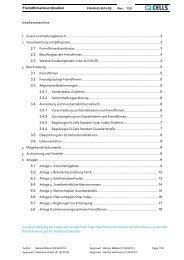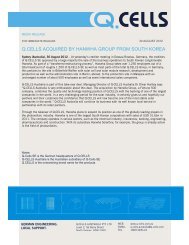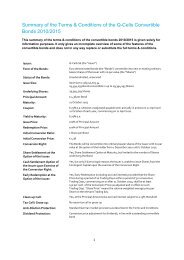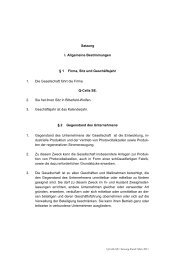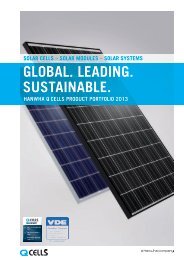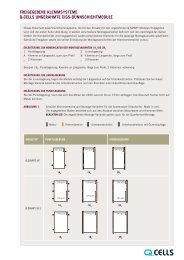Q CELLS - Installation manual G3 solar modules - Hanwha Q CELLS
Q CELLS - Installation manual G3 solar modules - Hanwha Q CELLS
Q CELLS - Installation manual G3 solar modules - Hanwha Q CELLS
You also want an ePaper? Increase the reach of your titles
YUMPU automatically turns print PDFs into web optimized ePapers that Google loves.
2 PLANNING<br />
2.4 Electrical layout<br />
Module Selection<br />
For detailed key electrical data, please refer to the<br />
product data sheet for the respective product.<br />
ÄÄOnly connect <strong>modules</strong> of the same type and the same<br />
power class.<br />
Safety Factor<br />
During normal operation, a module may generate a greater<br />
current and / or higher voltage than that determined under<br />
standardized test conditions. Please use a safety factor of<br />
1.25 for the following:<br />
• Calculating the voltage measurement values (V oc<br />
) of<br />
components<br />
• Calculating the current measurement values (I SC<br />
) of<br />
conductors<br />
• Sizing of control systems connected to the outlets of<br />
the <strong>solar</strong> <strong>modules</strong><br />
ÄÄPlease follow the valid national guidelines for the<br />
installation of electrical systems.<br />
Series Connection<br />
Connection of <strong>modules</strong> in series is only permitted up to<br />
the maximum system voltage as listed in the applicable<br />
data sheet.<br />
ÄÄTake into account all possible operating situations and all<br />
relevant technical norms and regulations when designing<br />
the system. This will ensure that the maximum system<br />
voltage, including all necessary safety margins, is not<br />
exceeded.<br />
ÄÄTake the voltage limit of the inverter into account when<br />
determining the string length.<br />
Parallel Connection<br />
Modules may be damaged by the occurrence of reverse<br />
currents (caused by module defects, ground leaks, or<br />
defective insulation).<br />
ÄÄEnsure that the maximum reverse current load capacity<br />
indicated in the data sheet is observed.<br />
In order to limit reverse currents that may occur, we<br />
recommend using the following safety options:<br />
1) Layout with a limited number of parallel connected<br />
strings :<br />
Without undertaking further current blocking measures,<br />
a maximum of two module strings may be operated in<br />
parallel on an inverter or MPP tracker.<br />
2) Layout with string diodes :<br />
if more than two strings are connected in parallel, a<br />
respective maximum of two strings must be protected<br />
against reverse currents from the remaining system with<br />
a shared string diode.<br />
3) Layout with string fuses :<br />
place fuses for each string of <strong>modules</strong> at the plus and<br />
minus ends. Observe the maximum permitted number<br />
of strings as indicated in the specifications provided by<br />
the respective string fuse manufacturer and the technical<br />
guidelines.<br />
NOTE!<br />
When installing different product versions, the lowest<br />
minimum permitted reverse current load capacity applies.<br />
Inverters<br />
Inverters with or without transformers may be used.<br />
10 INSTALLATION AND OPERATION MANUAL SOLAR MODULES GENERATION 3 (<strong>G3</strong>) – HANWHA Q <strong>CELLS</strong> GMBH – EN




